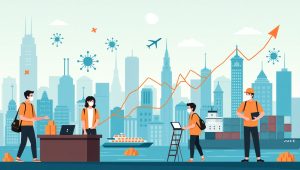
The economic impact of the COVID-19 pandemic has been profound, affecting nearly every sector of the global economy. From small businesses to large corporations, from low-income workers to high-level executives, the disruptions caused by the pandemic were felt worldwide. As we move further away from the peak of the crisis, many countries are beginning to see signs of recovery, but the path to full economic recovery is complex, uneven, and still uncertain. This article provides an update on the current state of the economic recovery from COVID-19, highlighting key trends and challenges.
One of the most significant aspects of the economic recovery is the global vaccine rollout, which has helped many countries manage the public health crisis and provided a foundation for economic stabilization. Countries that have successfully vaccinated a large proportion of their population have seen faster recoveries, as vaccines reduce hospitalizations and deaths, allowing businesses to reopen and people to return to work. For example, nations like the United States, the United Kingdom, and parts of the European Union, where vaccination rates are relatively high, have experienced a stronger economic rebound, with GDP growth rates returning to pre-pandemic levels.
However, the recovery has not been uniform across the globe. Low-income countries, particularly those in Africa and parts of Asia, continue to struggle with vaccine distribution and face significant barriers to economic recovery. Limited access to vaccines, along with ongoing supply chain disruptions, inflationary pressures, and political instability, has made it much harder for these regions to recover at the same pace. The World Bank and International Monetary Fund (IMF) have warned that the global recovery could be further delayed if these disparities are not addressed, calling for more equitable vaccine distribution and financial support for developing nations.
Another critical element of the recovery is the labor market. In many developed countries, unemployment rates have decreased as businesses reopen and demand for goods and services increases. However, the labor market has not returned to normal in many sectors. Some industries, such as hospitality and tourism, are still struggling with staff shortages and are finding it difficult to attract workers back. This is partly due to health concerns, ongoing childcare responsibilities, and shifts in worker preferences. Many employees are re-evaluating their careers and opting for remote or flexible work arrangements, leading to what some have called the “Great Resignation” in countries like the U.S.
In addition to challenges in the labor market, inflation has become a key issue in many economies. The combination of supply chain disruptions, rising energy prices, and increased demand as economies reopen has led to higher costs for goods and services. This has put pressure on consumers, particularly in sectors like food, housing, and transportation. Central banks in major economies, including the U.S. Federal Reserve and the European Central Bank, have begun to tighten monetary policies by raising interest rates to combat inflation, which could slow down the recovery process if not carefully managed.
Supply chain issues, which were a major challenge during the height of the pandemic, continue to disrupt the global economy. While there has been progress in getting supply chains back on track, delays in shipping, shortages of key materials like semiconductors, and labor shortages in manufacturing and logistics sectors are still prevalent. These issues are contributing to inflation and are expected to take some time to fully resolve.
In conclusion, while there are promising signs of economic recovery from the COVID-19 pandemic, the path remains uneven and fraught with challenges. High vaccination rates, government stimulus measures, and the gradual reopening of economies have contributed to growth in many regions, but issues like labor shortages, inflation, and unequal vaccine distribution continue to hinder a full recovery. Governments and international organizations will need to work together to ensure a more equitable and sustainable recovery, particularly in regions that have been left behind.